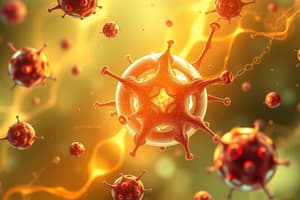Podcast
Questions and Answers
מהו המונח המתאר את הקשר בין מינון התרופה לריכוזה בפלזמה או באתר ההשפעה לאורך זמן?
מהו המונח המתאר את הקשר בין מינון התרופה לריכוזה בפלזמה או באתר ההשפעה לאורך זמן?
- פרמקוקינטיקה (correct)
- פרמקוגנוזיה
- פרמקומיקס
- פרמקודינמיקה
איזה מהבאים מתייחס לשינויים בתפוקת הלב המשפיעים באופן משמעותי על ההתנהגות הפרמקוקינטית של תרופות הרדמה?
איזה מהבאים מתייחס לשינויים בתפוקת הלב המשפיעים באופן משמעותי על ההתנהגות הפרמקוקינטית של תרופות הרדמה?
- טווח דינמי
- היסטרזיס
- קינטיקה קצהית (correct)
- קינטיקה אחורית
מה מתאר את טווח הריכוזים שבו מתרחשים שינויים בהשפעת התרופה?
מה מתאר את טווח הריכוזים שבו מתרחשים שינויים בהשפעת התרופה?
- היסטרזיס
- זמן דעיכה תלוי הקשר
- טווח דינמי (correct)
- קינטיקה של קצה קידמי
אילו עקרונות מאפיינים את גודל ומשך ההשפעה של תרופה, אך בעלי תועלת קלינית מוגבלת בגלל מתמטיקה מורכבת?
אילו עקרונות מאפיינים את גודל ומשך ההשפעה של תרופה, אך בעלי תועלת קלינית מוגבלת בגלל מתמטיקה מורכבת?
מהו המונח המתאר את העיכוב בזמן בין שינויים בריכוז הפלזמה והשפעת התרופה?
מהו המונח המתאר את העיכוב בזמן בין שינויים בריכוז הפלזמה והשפעת התרופה?
מהו אתר האפקט?
מהו אתר האפקט?
אילו גורמים יש לקחת בחשבון בעת קביעת המינון הנכון של תרופה?
אילו גורמים יש לקחת בחשבון בעת קביעת המינון הנכון של תרופה?
מה מתאר מה תרופה עושה לגוף?
מה מתאר מה תרופה עושה לגוף?
איזה מהבאים אינו מהווה מרכיב של פרמקוקינטיקה?
איזה מהבאים אינו מהווה מרכיב של פרמקוקינטיקה?
מהי המטרה של מתן שילוב של תרופות?
מהי המטרה של מתן שילוב של תרופות?
אילו אוכלוסיות מיוחדות יש לקחת בחשבון?
אילו אוכלוסיות מיוחדות יש לקחת בחשבון?
איזה מודל מפשט יתר על המידה את חלוקת התרופות בכל הפלזמה והרקמות?
איזה מודל מפשט יתר על המידה את חלוקת התרופות בכל הפלזמה והרקמות?
מהי המשוואה להערכת נפח התרופה?
מהי המשוואה להערכת נפח התרופה?
אם לתרופה יש סילוק בשיעור מסדר ראשון, מה יקרה?
אם לתרופה יש סילוק בשיעור מסדר ראשון, מה יקרה?
מה קורה בנפחי חלוקת התרופות?
מה קורה בנפחי חלוקת התרופות?
איזו תרופת הרדמה היא בעלת נפח חלוקה גדול מאד?
איזו תרופת הרדמה היא בעלת נפח חלוקה גדול מאד?
מה מתאר קצב סילוק תרופה מהפלזמה/דם?
מה מתאר קצב סילוק תרופה מהפלזמה/דם?
אילו תהליכים תורמים לפינוי תרופות?
אילו תהליכים תורמים לפינוי תרופות?
באיזה יחידות מוגדר סילוק?
באיזה יחידות מוגדר סילוק?
כאשר מקבילים בין כמות תרופה שסולקה לריכוז, זה תמיד יחזיר איזה ערך?
כאשר מקבילים בין כמות תרופה שסולקה לריכוז, זה תמיד יחזיר איזה ערך?
מהי משוואת הסילוק ממצב יציב?
מהי משוואת הסילוק ממצב יציב?
מה קורה כאשר מנה ניתנת, והמיכל מעורבב היטב?
מה קורה כאשר מנה ניתנת, והמיכל מעורבב היטב?
על פי המודל הפיזיוליגי לסילוק, מהו שמתאר ביטוי היטב?
על פי המודל הפיזיוליגי לסילוק, מהו שמתאר ביטוי היטב?
עבור תרופות עם יחס סילוק לינייארי, מה יקרה?
עבור תרופות עם יחס סילוק לינייארי, מה יקרה?
עבור תרופות שה-ER שלהן באופן עקבי נמוך מ-1, אילו מסקנות אנו יכולים להסיק?
עבור תרופות שה-ER שלהן באופן עקבי נמוך מ-1, אילו מסקנות אנו יכולים להסיק?
באופן כללי, כיצד מסולקות רוב תרופות ההרדמה?
באופן כללי, כיצד מסולקות רוב תרופות ההרדמה?
יצרית מסגרות להשוואת בין תרופות ולתאר כיצד תרופות מתנהגות, פותחו מודלים פרמקוקינטיים איך המודלים האלו פועלים?
יצרית מסגרות להשוואת בין תרופות ולתאר כיצד תרופות מתנהגות, פותחו מודלים פרמקוקינטיים איך המודלים האלו פועלים?
מודלים פרמקוקינטיים תאיים מבוססים על מה?
מודלים פרמקוקינטיים תאיים מבוססים על מה?
מה מתקבל מבעלות פוטנציאל קצר טווח?
מה מתקבל מבעלות פוטנציאל קצר טווח?
סילוק מרכזי מתייחס למה?
סילוק מרכזי מתייחס למה?
מה מגדירים קבועי קצב מיקרו?
מה מגדירים קבועי קצב מיקרו?
לסילוק סם האם יכולים להיות שני פרופילי שטיפה?
לסילוק סם האם יכולים להיות שני פרופילי שטיפה?
מהי מטרת ההכפלה של שני הצדדים לנפח ההפצה?
מהי מטרת ההכפלה של שני הצדדים לנפח ההפצה?
מולקולומפרמנטים מרובים מדומים למה?
מולקולומפרמנטים מרובים מדומים למה?
תכונה מכרעית סף פאזת ההשמנה היא מה?
תכונה מכרעית סף פאזת ההשמנה היא מה?
עבור איזה תרחיש ממשיכה יטופל התוים למטרת הצלבות של מדענים פרקוסיינטייים?
עבור איזה תרחיש ממשיכה יטופל התוים למטרת הצלבות של מדענים פרקוסיינטייים?
מהו התרחיש המכרוז בחדירות חברת הכביסה בחריצות צרליףם?
מהו התרחיש המכרוז בחדירות חברת הכביסה בחריצות צרליףם?
מה מהבאים מצהיר על בסיסי המורכביות של כגון?
מה מהבאים מצהיר על בסיסי המורכביות של כגון?
בדרך כלל התוצאה של יחסי הגומלין בין הפלא בין המנגיון ולקריעה לבין האינדיביום, למוקד התנהל כמעיר לוחצת נתונה?
בדרך כלל התוצאה של יחסי הגומלין בין הפלא בין המנגיון ולקריעה לבין האינדיביום, למוקד התנהל כמעיר לוחצת נתונה?
מה קורה בריכה לתוכניות שוויוניות?
מה קורה בריכה לתוכניות שוויוניות?
למה משווה התרבות חלימה תמיקח?
למה משווה התרבות חלימה תמיקח?
Flashcards
פרמקוקינטיקה
פרמקוקינטיקה
מתאר את הקשר בין מינון התרופה לריכוז התרופה בפלזמה או באתר ההשפעה לאורך זמן. חלוקה וסילוק (מטבוליזם והפרשה) קובעים קשר זה.
זמן ירידה תלוי הקשר
זמן ירידה תלוי הקשר
הזמן הנדרש כדי להגיע לריכוז פלזמה מסוים לאחר סיום עירוי ארוך.
היסטריה
היסטריה
מתייחס לעיכוב הזמן בין שינויים בריכוז הפלזמה והשפעת התרופה. זה לוקח בחשבון את הזמן שדרוש לתרופה להתפשט מהפלזמה לאתר הפעולה
פרמקודינמיקה
פרמקודינמיקה
Signup and view all the flashcards
ריכוז אתר השפעה
ריכוז אתר השפעה
Signup and view all the flashcards
טווח דינמי
טווח דינמי
Signup and view all the flashcards
קינטיקה חזיתית
קינטיקה חזיתית
Signup and view all the flashcards
נפח הפצה
נפח הפצה
Signup and view all the flashcards
אישור
אישור
Signup and view all the flashcards
סדר אפס לעומת קינטיקה מסדר ראשון
סדר אפס לעומת קינטיקה מסדר ראשון
Signup and view all the flashcards
זמן מחצית חיים
זמן מחצית חיים
Signup and view all the flashcards
מודלים פיזיולוגיים
מודלים פיזיולוגיים
Signup and view all the flashcards
מודלים של מדורים
מודלים של מדורים
Signup and view all the flashcards
פרמקוקינטיקה
פרמקוקינטיקה
Signup and view all the flashcards
תצוגות סמים
תצוגות סמים
Signup and view all the flashcards
אינטראקציות סמים
אינטראקציות סמים
Signup and view all the flashcards
סובלנות
סובלנות
Signup and view all the flashcards
טכיפילקסיס
טכיפילקסיס
Signup and view all the flashcards
עֹצמָה
עֹצמָה
Signup and view all the flashcards
יְעִילוּת
יְעִילוּת
Signup and view all the flashcards
Study Notes
Basic Principles of Pharmacology
- Pharmacokinetics shows the link between drug dosage and drug concentration over time.
- Distribution and elimination affect this relationship for anesthetic drugs.
- Estimates of distribution volumes and clearances come from mathematical formulas. These are based on blood or plasma concentrations after giving a known drug dose over time.
- Front-end kinetics are heart alterations that affect drugs' effects (onset, duration).
- Context-sensitive decrement time marks how long it takes to reach a plasma concentration after stopping long infusions.
- Hysteresis refers to the time it takes for drug effects to show up after concentration changes.
- Hysteresis includes how long it takes for drug to move from plasma to action site and then to have an effect
- Pharmacodynamics studies what drugs do to the body.
- It links drug concentration to its effects.
- Effect-site concentration involves mathematically determining where an anaesthetic drug works.
- Cannot show mechanism of action like drug-receptor interaction
- A single anaesthetic drug can cause several different effects which occur at different effect-site concentrations:
- Analgesia
- Ventilatory depression
- Loss of response to laryngoscopy
- Changes in electroencephalogram
- Dynamic range is when drug effect changes with concentration.
- Outside this range, drugs aren't effective enough or don't provide additional effect.
- Anesthesia uses drug interactions.
- Anesthetics combine drugs for hypnosis, analgesia, and muscle relaxation.
- Drugs interact such that when administered together, they don't act as if they were given alone.
- Pharmacokinetic and pharmacodynamic principles highlight drug effect magnitude and timeline.
- They have limited clinical use because of complex calculations.
- Computer displays show how drugs act in real-time, which is a breakthrough.
- Special patients must have the correct dose via:
- Age
- Body habitus
- Gender
- Chronic exposure:
- Opioids
- Benzodiazepines
- Alcohol
- Presence of:
- Heart disease
- Lung disease
- Kidney disease
- Liver disease
- Extent of:
- Blood loss
- Dehydration
- Anesthetic medicine changes due to obesity and age
- Anesthetic behavior is weakly linked to use of opioids and renal failure.
Intro To Pharmacology for Anesthesia
- This section is made up of three parts:
- How drugs move around the body
- The effects that drugs have
- How patient traits affect choices
- Pharmacokinetics regards drug amount in body relating to concentration at action point
- Core Concepts:
- Volumes of distribution
- Drug clearance
- Drug transfer
- Pharmacodynamics links amounts of drug to the drug effects
- Most anesthesia uses several drugs for:
- Pain relief
- Sedation
- Muscle relaxation
- Patient biology is important to how they respond to drugs and it is determined by:
- Age
- Weight
- Gender
- Existing and historical exposure to:
- Opioids
- Benzodiazepines
- Alcohol
- Dysfunction of:
- Heart
- Lung
- Kidney
- Liver
- How well they compensate for:
- Blood loss
- Dehydration
- Age and weight are important considerations
Pharmacokinetics Concepts
- It links drug concentration to its movement through out body
- Movement factors:
- Absorption (not relevant to IV)
- Distribution
- Metabolism and Excretion
- The timespan of IV drugs relies on volume and clearance
- Models can predict levels of concentration after amount given
Volume of Distribution
- An over-simplified model is that a drug is diluted into a water tank.
- Distribution volume regards size of tank where known amount of drug spread evenly after a time.
- How distribution is estimated: An injected medicine (mg) dissolves in tank where volume is estimated by looking at concentration (mg/L)
- Vd = amount/concentration
- Body isn't tank but this helps calculate appropriate dose and figure out drug effect once levels stabilizes
- Because body clears drugs almost immediately, a faucet in these models represents body removing drug
- If the drug removal in the tank changes concentration, volume is estimated with the amount and concentration over time:
- Vd=Amount(t)/Concentration(t)
- If drug is removed at a constant rate, its estimate can be constant
- However, IV introduced medicines don't stay and usually travel to tissues
- Peripheral distributes volume to a central one with blood
- Sizes in periphery show how blood soluble the drug is.
- High peripheral solubility means larger dispersion and lowers measurable concentration
- So, total amount of distribution bigger than starting dose.
- Anesthetics (fentanyl) can spread to 4L/kg but vascular is lower at 0.07 L/kg or 0.2 L/kg on extra.
Elimination Example
- A tank gets continuously drained at 50% of the total every 120 minutes. The level goes 10 to 5 to 2.5 mg/ml
- The estimates remain that Vd is at 1 L
- Volume distribution doesn't change as the drug gets eliminated
- In two tanks, distribution changes.
- Measuring concentrations is made difficult with tissue
- Schematic models plasma and tissue volumes
- Ellipses show drug tied up in tissue
- 10mg injected and reading of 2.5 uses 4L
- Anesthetic doses need to take the changing Vd volume into consideration as with varying volume is an outcome with bolus/infusion
Clearance
- Clearance measures quickness of drug removal
- Systemic releases through excretion or change
- Tank release is systemic and is “intercompartmental”
- Intercompartmental transfers drug between tanks
- Clearance measures how much liquid is being clear of drugs at a certain measurement
- Clearance amount isn't elimination
- With first order estimates, high concentration causes rates of removal is high
- Clearance independent rate/time based so good to measure drug
Visualizing Clearance
- The quantity in tank and how it moves at 1L/min rate, as a way to evaluate its constant removal.
- Amount eliminated is related to its level as “first order”. The initial change as "Drug concentration" changes greater than what is observed later.
- Drug at Time-A is quicker while window changes in "Drug concentration B" from 3-4 minutes
- Elimination shows mg/ml over how it breaks down: A is from 28 down to 14. B is from 10.4 down to about 5.
- Estimate as the ratio of how much drug scaled to concentration for amount of volume
- The "amount of drug in Tank= Concentration+Clearance in relationship to amount of drug in ml or microgram".
Equations of Clearance
- Amount that is to be eliminated is equal that the location is under graph.
- Clearance can then be is the dose or size of area in graph.
- Constant IV gives state where removed equalled rate.
- Then ratio of rates can be understood where Css is continuous stage.
- Volume of drug and it being cleansed equals level of what's around with flow to volume is 1L/min
- Continuous drugs are consistent as drugs get cleaned all the time because kinetics constant.
- When first injected and volume equal to 4 L equals 64 mg then as the body reacts it eliminates and lowers it.
- This all goes down as drug broken.
Mass Balance
- Amount of drug flows by organ equals rate it enters in balance to metabolism.
- Amount getting removed over C-in and C-out.
- Total clearance equals metabolic organ
- Hepatic is how it is then how ER relates.
- Low extraction the flow does not change effect
- All extracted then large metabolism rate is flow limited: hepatic goes reduces.
- Moderate affects may have little affect
Rates
- Volume has first rate and has constant and inverses it
- Extraction models need to be examined.
Models
- Pharmacology depends on time as is with bolus amounts. Can use physiologic or “curve models."
- Physiology depends on blood organ
- Curve are complex
- Simple depends to know is good and useable to figure out levels that are right.
- Modeling can be transformed with variables
Compartment Models
- They used when calculating curve levels
- They made off formula
- Kinetic changed as clearance changes
- Three stages with one central and two outward as all equals one final volume
Rate Example
- System clearance removes both the outward and central.
- Rate are drug change from compartment I to J
- 1-0 is is central to out
- Two is how it enters and leaves
- These are all from the models.
- Rates have zero in constant while first are amount relative.
- Amounts change the rates in first.
- One needs sat the rates change
One Compartment Model
- Formula is A(t) as amount equal A zero as constant and change over time
- Volume and time relate to "concentration", with an opposite reaction if it is too quick or slow
- Volume= the amount of concentration or a set.
Multi Example
- This requires constant change:
- Rate of level drops
- Initial is greater
- Fast rate early after shot
- Has medium and slow
- Long it is over will it move into the slow.
Visual aid
- It moves to two tanks and as it moves that way tanks change, the more they change or are slow the longer that part acts to decrease levels or has effect.
- Rate changes make some drugs slow to reduce or take time for the drug to finally leave.
Studying That Suits You
Use AI to generate personalized quizzes and flashcards to suit your learning preferences.




